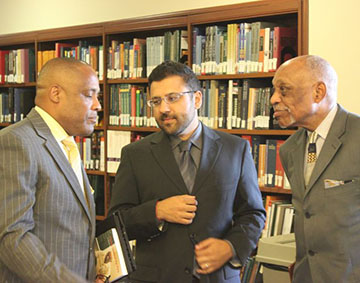
Men of faith: Reverend Mark Whitlock, Dr. Varun Soni and Reverend Dr. Cecil “Chip” Murray prepare to speak at the “Twice Tested by Fire” reception at the USC Doheny Memorial Library. Photo: Alec Faulkner www.alecfaulkner.com.
Members of the Los Angeles community gathered at the University of Southern California Doheny Memorial Library on October 2nd to listen to veteran community leader Reverend Dr. Cecil “Chip” Murray discuss struggles faced by humanity and the efforts needed to overcome them. USC staff and faculty, congregation members of Dr. Murray’s First African Methodist Episcopal (F.A.M.E.) Church in South LA and other guests listened to the retired pastor and current USC Religion & Civic Culture faculty member reflect on the history of his own life and the United States as a whole while celebrating the publication of his 2012 autobiography “Twice Tested By Fire.”
Faith under fire
Dr. Murray has been known as a hero in the Los Angeles community for decades and has a name that has been attached to many titles and awards, but USC President Dr. Max Nikias stressed that “these titles don’t tell the whole story.” After being introduced by Dr. Nikias and USC Dean of Religious Life Dr. Varun Soni, who pointed out that October 2 was also the birthday of legendary Indian civil rights leader Mahatma Gandhi, Dr. Murray deflected the praise and attention he received and pointed out that his struggle is part of a larger human struggle.
“Understanding (that) we are family is the challenge of the 21st century. The pain is not going to go away. The fire is not going to go away. The truth is we are not saved from the fire: we are saved in the midst of the fire,” said Dr. Murray in an analogy to his near-death experience which occurred when his Air Force jet caught on fire in 1957.

Community Catalyst: Dr. Cecil “Chip” Murray receives a proclamation in honor of his community service and 83rd birthday from City of Los Angeles Community Services Officer Josefina Salvador on behalf of LA Mayor Antonio Villaraigosa. Photo: Alec Faulkner www.alecfaulkner.com.
The next step
Despite being praised by members of the USC community and being recognized with a proclamation from the City of Los Angeles for his efforts thus far, Dr. Murray refused to focus on his awards and instead chose to discuss the dire need for social justice for South Los Angeles and other underserved communities around the world.
“All of us are constantly tested by fire. Half of the people of the world live on less than two dollars a day. We have a long way to go. Seeing that we are family, we will get there. But our chauffeur will be necessity,” said Dr. Murray, who added that all humans are “kin under the skin.”
History lesson
While also focusing on the future, Dr. Murray referenced the 1992 riots that swept across South LA and other underserved communities in Southern California and pointed out the set of root causes first highlighted by Dr. Martin Luther King.
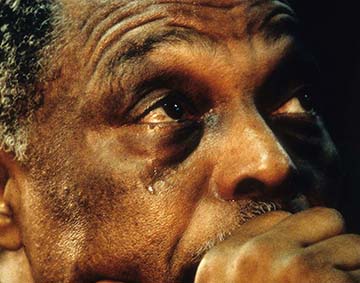
“Poverty, racism and war were the combination that caused not only the 1992 riots, but the 1965 riots in Los Angeles as well. The poverty rate in underserved black communities is double the national rate,” said Dr. Murray, who recently celebrated his 83rd birthday and was inspired by the 1992 riots to create social justice for communities of color.
Civic engagement within South LA, which has been spurred by organizations such as Community Coalition South Los Angeles, was highlighted as a key component of the solution to social ills during the final moments of Dr. Murray’s speech.
“We have enough resources to change our neighborhoods. We have an obligation to rise to the occasion,” said. Dr. Murray.
“If we don’t do it, who will?”
This event was hosted by USC Spectrum.
Elias Kamal Jabbe is the Founding Editor of MulticulturalMatters.org









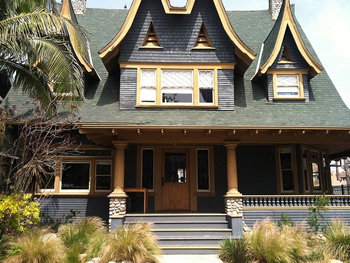 It is a landmark and a piece of history, but these days, it’s something else entirely: a recreation center.
It is a landmark and a piece of history, but these days, it’s something else entirely: a recreation center. Joseph Depuy built the home in 1902 and it stayed in his family until the 1970s. The city bought it for a street-widening project that would never happen. When plans took shape to demolish the house in the mid-90s, the community stepped in. Laura Meyers formed the South Seas House Action Committee with many other members of the community. She says saving the house became something more during a turbulent time in Los Angeles history.
Joseph Depuy built the home in 1902 and it stayed in his family until the 1970s. The city bought it for a street-widening project that would never happen. When plans took shape to demolish the house in the mid-90s, the community stepped in. Laura Meyers formed the South Seas House Action Committee with many other members of the community. She says saving the house became something more during a turbulent time in Los Angeles history. Not in South Los Angeles, where property is selling in some areas. Leimert Park-based real estate agent Heather Presha (pronounced Pre-shay) said that homes on the market in her neighborhood and neighboring areas of Baldwin Hills/Crenshaw, View Park, Baldwin Village, Hyde Park, and Jefferson Park are getting 40 to 50 offers each. Open houses are filled to capacity with prospective buyers. “It’s so competitive now, I haven’t made an offer on a home in six months that hasn’t had multiple offers,” said Presha.
Not in South Los Angeles, where property is selling in some areas. Leimert Park-based real estate agent Heather Presha (pronounced Pre-shay) said that homes on the market in her neighborhood and neighboring areas of Baldwin Hills/Crenshaw, View Park, Baldwin Village, Hyde Park, and Jefferson Park are getting 40 to 50 offers each. Open houses are filled to capacity with prospective buyers. “It’s so competitive now, I haven’t made an offer on a home in six months that hasn’t had multiple offers,” said Presha.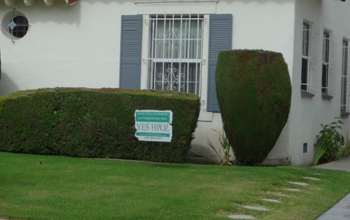 With interest rates at historically low levels of 3% or less, it’s a good time to buy if you can get a loan. Neith said if you’re buying an historic property – one that is in an Historic Preservation Overlay Zone, or HPOZ, or one that is outside an HPOZ but designated historic – then you may qualify for significant property-tax reduction under the Mills Act. The Mills Act allows tax reduction of 50 percent to 75 percent for ten years after purchase. Owners can apply for renewal after the ten-year window. However, all money saved under the act must be used for historical restoration. The West Adams area alone has at least six HPOZs.
With interest rates at historically low levels of 3% or less, it’s a good time to buy if you can get a loan. Neith said if you’re buying an historic property – one that is in an Historic Preservation Overlay Zone, or HPOZ, or one that is outside an HPOZ but designated historic – then you may qualify for significant property-tax reduction under the Mills Act. The Mills Act allows tax reduction of 50 percent to 75 percent for ten years after purchase. Owners can apply for renewal after the ten-year window. However, all money saved under the act must be used for historical restoration. The West Adams area alone has at least six HPOZs.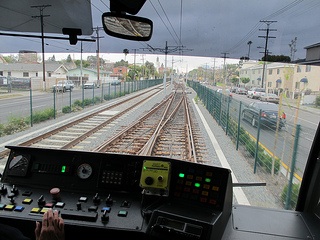 Recent improvements in South L.A. have made it a much more attractive prospect for homebuyers. The recently-contructed light rail Expo Line, which follows an old rail-line cut, is part of what Neith said is an overall feeling of good things happening in the neighborhoods along it. Even those who don’t use it think it’s “part and parcel of progressive improvement in Los Angeles.”
Recent improvements in South L.A. have made it a much more attractive prospect for homebuyers. The recently-contructed light rail Expo Line, which follows an old rail-line cut, is part of what Neith said is an overall feeling of good things happening in the neighborhoods along it. Even those who don’t use it think it’s “part and parcel of progressive improvement in Los Angeles.” 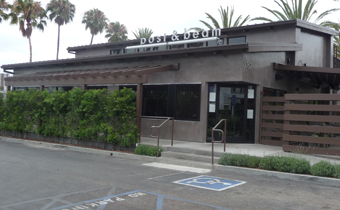 One business that thinks South L.A. is a good investment is the top-rated restaurant Post and Beam, which opened near the Baldwin Hills Crenshaw Plaza mall in 2011. With a star chef who also happens to be a local boy made good—Chef Govind Armstrong grew up in Inglewood—Post and Beam serves a locally-sourced menu driven by ingredients, many of which are raised in the restaurant’s own organic garden. It would be perfectly at home in the moneyed environs of the Westside. Yet it’s filled to capacity weekly by Baldwin Hills locals hungry for quality food and quality places nearby to spend their money in. Real estate agent Presha said, “It’s what we deserved.”
One business that thinks South L.A. is a good investment is the top-rated restaurant Post and Beam, which opened near the Baldwin Hills Crenshaw Plaza mall in 2011. With a star chef who also happens to be a local boy made good—Chef Govind Armstrong grew up in Inglewood—Post and Beam serves a locally-sourced menu driven by ingredients, many of which are raised in the restaurant’s own organic garden. It would be perfectly at home in the moneyed environs of the Westside. Yet it’s filled to capacity weekly by Baldwin Hills locals hungry for quality food and quality places nearby to spend their money in. Real estate agent Presha said, “It’s what we deserved.”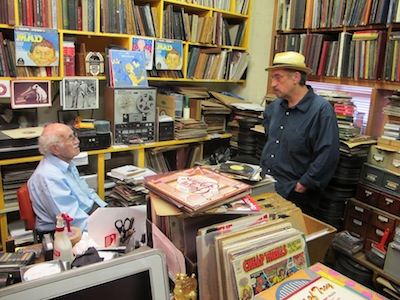
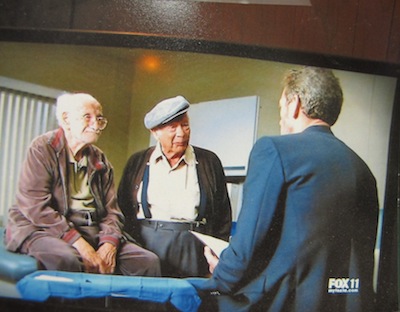
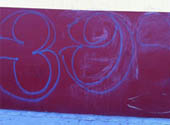 “Wait a second, there was an urban legend that there was a judge that was painting out graffiti,” Totten said.
“Wait a second, there was an urban legend that there was a judge that was painting out graffiti,” Totten said. 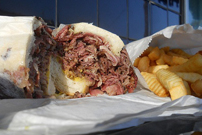 Johnny’s Pastrami on West Adams Boulevard has been described as a hole in the wall, scary and a “hood” landmark. If you search for it on Yelp, you’ll see a few meager stars and a whole lotta five stars. Whatever you think about the pastrami sandwiches at this South LA stop, there is no denying it’s a neighborhood fixture. Reporter Nick Edmonds paid a visit to see how the half-century eatery is faring.
Johnny’s Pastrami on West Adams Boulevard has been described as a hole in the wall, scary and a “hood” landmark. If you search for it on Yelp, you’ll see a few meager stars and a whole lotta five stars. Whatever you think about the pastrami sandwiches at this South LA stop, there is no denying it’s a neighborhood fixture. Reporter Nick Edmonds paid a visit to see how the half-century eatery is faring.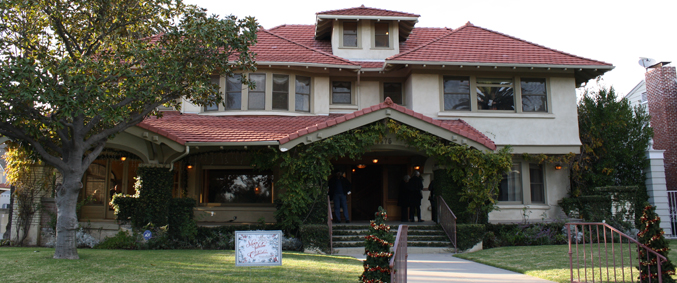
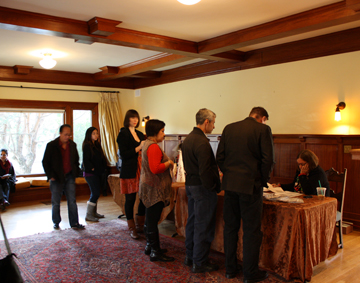 Later in the evening, groups gathered at the Welcome House for the start of the progressive dinner. Volunteers from WAHA led them through each course of the meal which was set up in a different house; from the Atomic-Age Appetizer House through the Salad and Dinner Houses, ending finally at a Spanish-style villa serving as the Dessert House.
Later in the evening, groups gathered at the Welcome House for the start of the progressive dinner. Volunteers from WAHA led them through each course of the meal which was set up in a different house; from the Atomic-Age Appetizer House through the Salad and Dinner Houses, ending finally at a Spanish-style villa serving as the Dessert House.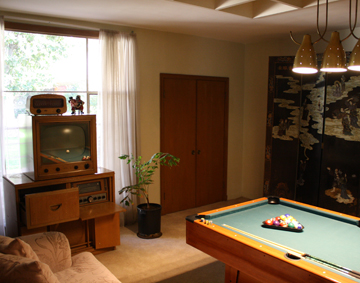 The Appetizer House is one example of this honesty. The swanky Atomic-Age residence is a Paul Williams design officially known as the Taylor Residence.
The Appetizer House is one example of this honesty. The swanky Atomic-Age residence is a Paul Williams design officially known as the Taylor Residence.  In the spring sunshine, lush greenery coats the garden. This season, vegetables can be found throughout the space, including artichokes, lemon grass and lettuce. Along the wood chip path, a cage of bunnies and compost stations can also be found. But the garden hasn’t always looked this way.
In the spring sunshine, lush greenery coats the garden. This season, vegetables can be found throughout the space, including artichokes, lemon grass and lettuce. Along the wood chip path, a cage of bunnies and compost stations can also be found. But the garden hasn’t always looked this way. In 1983, WAHA was founded as a neighborhood association. Noticing that the majority of people moving into the area had an interest in historic homes, WAHA morphed into a preservation advocacy group.
In 1983, WAHA was founded as a neighborhood association. Noticing that the majority of people moving into the area had an interest in historic homes, WAHA morphed into a preservation advocacy group.




